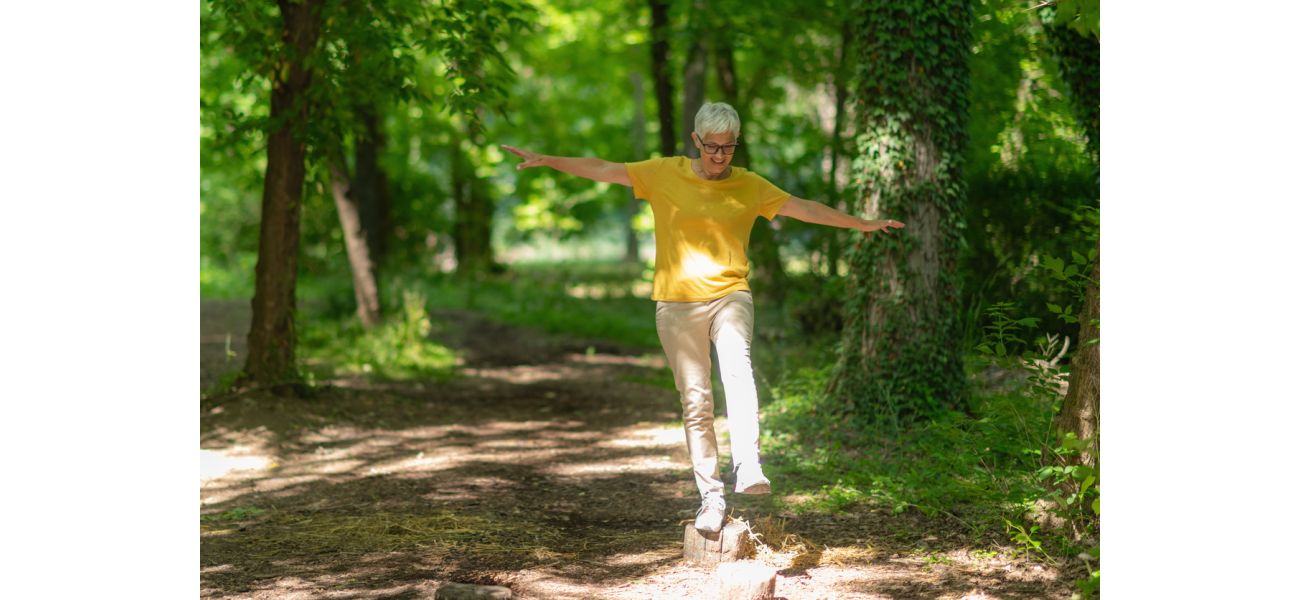Youthful balance may mean longer one-legged stance.
As people age, their ability to balance on one leg decreases.
October 24th 2024.

Did you know that balancing on one leg isn't just something that flamingos and other birds do? It turns out that it can also be a good indicator of your overall health, according to a recent study.
Researchers wanted to see how well people over the age of 50 could balance on one leg, and what they found was quite interesting. As we age, our ability to balance on our dominant and non-dominant leg decreases significantly. In fact, it has a greater decline than our gait (how we walk) and our muscle strength. This study was published in the journal PLOS One.
The study involved 40 participants who were all in good health and had no neuromuscular disorders. They were asked to stand on one leg and the researchers measured how long they could maintain their balance. They found that on average, people were able to hold the stance for 2.2 seconds less per decade on their non-dominant leg and 1.7 seconds less on their dominant leg. This decline was consistent for both men and women, even when taking into account differences in body size.
Dr. Kaufman, one of the researchers involved in the study, explained the importance of good balance. Not only does it allow us to carry out our daily activities without fear of falling, but it also leads to healthy aging and an improved quality of life.
Previous research has shown that our ability to balance naturally decreases with age. This new study compared it to other factors such as hand grip and knee strength, as well as gait speed. While all of these measurements declined with age, the ability to balance on one leg deteriorated at a much faster rate.
So, how long should we be able to stand on one leg? According to Dr. Kaufman, a good rule of thumb is to be able to hold the stance for 30 seconds or longer if you are 69 or younger, 20 seconds if you are 70 to 79, and 10 seconds if you are over 80. This simple test can be done at home without any special equipment and can give you a good idea of your overall balance and potential risk for falls.
If you struggle to maintain your balance for more than five seconds, it may be a sign of an underlying health condition. Dr. Kaufman recommends making an appointment with your physician to discuss any concerns.
But don't worry, there are ways to improve your balance as you age. Dr. Kaufman suggests staying physically active and working on your strength and balance. This can include activities like yoga, which focus on balance and can help you maintain your balance as you age. Another tip is to practice standing on one leg without rushing or falling, and if you're feeling ambitious, try putting on a sock while balancing on one leg!
In summary, balancing on one leg may seem like a simple task, but it can actually tell us a lot about our overall health and risk for falls. By keeping our balance as we age, we can improve our quality of life and prevent potential injuries. So next time you see a flamingo standing on one leg, remember that they may just be testing their health!
Researchers wanted to see how well people over the age of 50 could balance on one leg, and what they found was quite interesting. As we age, our ability to balance on our dominant and non-dominant leg decreases significantly. In fact, it has a greater decline than our gait (how we walk) and our muscle strength. This study was published in the journal PLOS One.
The study involved 40 participants who were all in good health and had no neuromuscular disorders. They were asked to stand on one leg and the researchers measured how long they could maintain their balance. They found that on average, people were able to hold the stance for 2.2 seconds less per decade on their non-dominant leg and 1.7 seconds less on their dominant leg. This decline was consistent for both men and women, even when taking into account differences in body size.
Dr. Kaufman, one of the researchers involved in the study, explained the importance of good balance. Not only does it allow us to carry out our daily activities without fear of falling, but it also leads to healthy aging and an improved quality of life.
Previous research has shown that our ability to balance naturally decreases with age. This new study compared it to other factors such as hand grip and knee strength, as well as gait speed. While all of these measurements declined with age, the ability to balance on one leg deteriorated at a much faster rate.
So, how long should we be able to stand on one leg? According to Dr. Kaufman, a good rule of thumb is to be able to hold the stance for 30 seconds or longer if you are 69 or younger, 20 seconds if you are 70 to 79, and 10 seconds if you are over 80. This simple test can be done at home without any special equipment and can give you a good idea of your overall balance and potential risk for falls.
If you struggle to maintain your balance for more than five seconds, it may be a sign of an underlying health condition. Dr. Kaufman recommends making an appointment with your physician to discuss any concerns.
But don't worry, there are ways to improve your balance as you age. Dr. Kaufman suggests staying physically active and working on your strength and balance. This can include activities like yoga, which focus on balance and can help you maintain your balance as you age. Another tip is to practice standing on one leg without rushing or falling, and if you're feeling ambitious, try putting on a sock while balancing on one leg!
In summary, balancing on one leg may seem like a simple task, but it can actually tell us a lot about our overall health and risk for falls. By keeping our balance as we age, we can improve our quality of life and prevent potential injuries. So next time you see a flamingo standing on one leg, remember that they may just be testing their health!
[This article has been trending online recently and has been generated with AI. Your feed is customized.]
[Generative AI is experimental.]
0
0
Submit Comment





